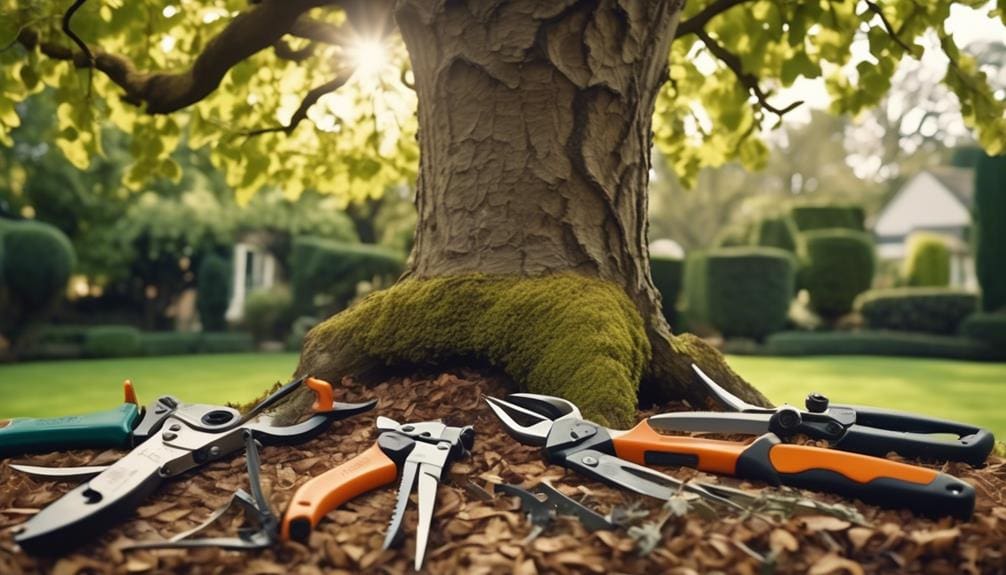Tree Health and Maintenance
Oak Tree Pruning Secrets Unveiled
As we gently shape the future of our oak trees, we’ve discovered that there’s much more to pruning than initially meets the eye. We’ve spent years honing our skills and we’re here to share our insights, ensuring you can maintain the health and aesthetics of these majestic beings.
Pruning isn’t just about making strategic cuts; it’s an art that balances the tree’s natural growth patterns with the surrounding environment’s needs. We’ll guide you through the subtleties of timing, the selection of the right tools, and the essential steps to prevent disease while enhancing the tree’s form.
Let us lead you through the veiled intricacies of oak care, and reveal why these secrets can make all the difference for your leafy companions.
Key Takeaways
- Understanding oak tree biology and management is crucial for maintaining the size and health of oak trees.
- Pruning oak trees during the late winter or early spring, while the tree is dormant, reduces the risk of disease transmission and allows for optimal healing and growth.
- Selecting the right pruning equipment, such as hand pruners, loppers, and pruning saws, is essential for safe and efficient pruning.
- Regular pruning, along with proper watering, fertilization, and disease prevention measures, helps promote tree health and longevity.
Understanding Oak Tree Biology
To effectively manage oak tree growth, we must first grasp the complexities of their biology. Factors such as species, genetics, and the environment play pivotal roles in determining their size and health.
Delving into the specifics, we understand that tailored pruning, vigilant watering, and precise fertilization are crucial in controlling an oak’s stature. Techniques such as crown reduction and canopy thinning aren’t mere tasks; they’re calculated interventions based on a deep understanding of oak physiology.
For those seeking smaller statured oaks, dwarf and miniature varieties present viable options. Moreover, an intimate knowledge of these majestic beings is our best defense against threats like oak wilt, ensuring the longevity and vigor of both ancient and youthful specimens alike.
Timing Oak Tree Pruning
Having established the importance of understanding oak tree biology for effective growth management, we’ll now focus on the critical consideration of timing when it comes to pruning these resilient trees. Timing oak tree pruning correctly is essential for promoting healthy growth and avoiding detrimental effects. Here’s what we need to remember:
- Dormant Season: Prune during late winter or early spring before the sap starts flowing.
- Disease Prevention: This timing reduces the risk of disease transmission.
- Resource Allocation: It allows the tree to direct energy towards healing and spring growth.
- Avoid Growth Season: Refrain from pruning when the tree is actively growing to prevent stress and pest attraction.
Selecting Pruning Equipment


Selecting the right pruning equipment is crucial for tackling different sizes and types of oak branches effectively and safely. When we prune oak trees, we must ensure our tools are as precise and enduring as our intentions.
Hand pruners, ideal for snipping small branches, should boast high-quality blades that retain sharpness over time. For heftier limbs, we opt for loppers or robust pruning saws, designed to manage the increased diameter with clean cuts that promote swift healing.
Our equipment must have ergonomic handles and integral safety features to minimize the risk of injury. We carefully choose the size and weight of our tools, matching them to our strength and comfort level, ensuring our pruning sessions aren’t only safe but also efficient.
Step-by-Step Pruning Process
Armed with the right pruning tools, we’ll now explore the methodical approach to oak tree pruning, beginning with a thorough assessment of the tree’s health and structural integrity. Ensuring the trees grow strong and healthy, we’ll identify the branches that need attention.
Here’s our precise plan of action:
- Inspect & Mark: Scrutinize each limb, marking those that are dead, diseased, or improperly crossing others for removal.
- Lower Branches First: Start pruning from the bottom, directing growth upwards and ensuring a sturdy structure.
- Canopy Thinning: Carefully thin the upper canopy to enhance air circulation and sunlight penetration.
- Final Shaping: Control the tree’s height and spread, applying crown reduction if necessary to maintain a balanced, free-growing form.
Disease Prevention Tactics


To safeguard our oak trees against diseases, we must integrate regular pruning into our maintenance regimen, enhancing air flow and sunlight exposure to bolster tree health. We’re not just snipping at random; our disease prevention tactics are deliberate, aiming to remove dead or infected branches that could compromise the entire tree. By doing so, we halt the spread of disease, allowing the rest of the oak to thrive unencumbered.
We also advocate for proper watering and fertilization, fortifying the oak’s natural defenses. Considering disease-resistant varieties is another proactive measure we recommend. And, when necessary, we aren’t shy about applying preventive treatments like fungicides or insecticides. These are our calculated moves to ensure our oaks stand tall and disease-free, embodying the very essence of resilience and freedom.
Conclusion
In wrapping up, we’ve demystified oak tree pruning, delving into its biology and timing nuances. We’ve chosen precise tools and outlined a meticulous pruning strategy. Our tactics thwart diseases, safeguarding these majestic beings.
Embracing our guidance ensures your oaks thrive, reflecting our shared commitment to their enduring legacy. Let’s continue honing our skills, preserving these natural treasures for generations to come.
Remember, each cut shapes not just a tree, but the future of our ancient woodland heritage.


Hello there! I’m Logan Foster, the green-thumbed social media marketer behind the vibrant world of 1800TreeGuy.com. With roots firmly planted in arboriculture, I’ve branched out to help clients cultivate their dream outdoor spaces, one leafy canopy at a time. My knack for nurturing nature is more than a profession—it’s a way of life.
When I’m not talking trees and teaching the art of arboreal care, you can find me cheering on the Bulldogs—my alma mater’s pride and my forever team. My environmental studies there didn’t just teach me about ecosystems; they instilled a lifelong passion for protecting our planet.
Off the clock, I’m an adventurer at heart. Whether it’s trekking the Appalachian trails, pedaling down a mountain path, or crafting guides to share the wonders of the wild, I’m happiest with soil under my nails and the sun on my face. And let’s not forget Yoda, my pug sidekick. He may not have mastered the art of stillness, but his joyful grins are my daily dose of happiness.
I’m all about making connections—between people and the great outdoors and between my clients and their ideal landscape visions. My approach is personal; every tree has a story, and every garden reflects its caretaker.
If you want to green your scene or share in my outdoor escapades, give me a shout on Instagram or Facebook. Let’s cultivate a conversation and grow a community rooted in a love for the lush life.















